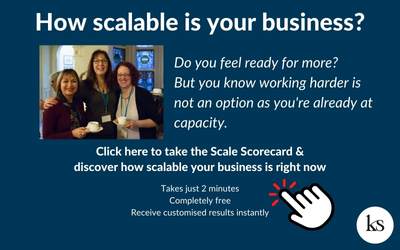If you run a busy business, it’s easy to feel responsibility for not only getting new leads and winning over new clients, but also for delivering the work and all the admin tasks that go along with that.
For most business owners I speak with, having a business operate without them being in the thick of everything, all the time can seem an impossibility.
So is it really possible for your business to operate twelve months of the year, whilst you take holidays, weekends away or even finish your work day at 3pm if that is what you want?
However much fire fighting you feel you are doing right now, I want to reassure you that yes, you can absolutely achieve this.
It isn’t something that can happen overnight but over the course of the next few months, you can start to shift yourself from being a busy freelancer to being a CEO of your business.
Step One – Your CEO Mindset
Start the transition from being the person who does it all, to being a business leader.
This starts with recognising your role as a freelancer (the part of you who does the delivery), your role as a business owner (the part of you who is responsible for the running of the business – sales, marketing, operations, finances) and your role as a CEO (the part of you who strategically plans long term and focuses on your next stage of growth).
This important first step helps you move away from ‘winging it and hoping for the best’ because when you are busy, busy, busy it’s no surprise that you can’t think or visualise what your bigger dreams are and where you could hope for your business to be in 5 years time.
You need to slow yourself down so you can clear the mental overload in your brain, and give you the space to clarify your professional and life goals and ambitions.
Have a read of my article next where I dive in to the problem of having an overloaded brain and the time impact it has your ability to long term plan.
Step Two – Get operational support
If you are running everything yourself, with maybe the odd bit of outsourcing of design work or ad hoc admin, then the first action to take is almost always to hire someone to help with your business operations.
If you have a virtual assistant working for you already, it may be time to review their role and assess whether you are ready to hire operations manager level support so that someone else takes on the day to day running of the business for you.
You need to free up some time so you can work ON your business, rather than IN it every day. Breaking this ‘do it all yourself’ habit, no matter what experiences you have had in the past, is essential if you want to be able to take time out of the business for holidays and shorter work weeks and days.
Don’t just hire anyone; it’s important that you write out a job description – what it is you feel you need help with and what kind of person you feel would bring out the best in you. If you don’t know where to start, then have a read of my how to hire an operations manager article.
Step Three – Get a grip of your finances
My version of profitability is not just the potential of your financial gain, but also how well your business model is set to ensure your business delivers the best results to your clients, with the time and energy you want to give.
If you haven’t done much work on your finances over the past few years except to sign off your tax return and company accounts, a deep dive into your finances to help you benchmark and track the numbers in your business is needed and this will help you make better decisions about where to focus.
Decisions such as:
- Are your prices right? Is the price you are charging not only giving you the income you want but also going to give you the cash flow to invest in your sales, marketing, systems & processes to support your delivery?
- Can you afford to outsource? Have you factored in your costs so you make sure you still get paid?
- When and where do you invest your time, energy, and resources? Where are your future profit opportunities, and when would be the right time to diversify or work with different audiences?
- Which products to stop offering and clients to ‘sack’? Are you really making ‘enough’ sales to justify your efforts?
- Can you invest in advertising? Are your sales going to give you the right return on investment?
Without taking a good look at your finances, you may be missing an easier or simpler route for your next stage of your growth.
And even if you have exceptional support from your accountant, this kind of financial work is rarely done because your statutory tax return and end of your accounts don’t give you the right financial information to help you spot your profitability and growth potential in your business.
Step Four – Review your products and service offerings
How easy it is to reach and take on more clients, and increase your revenue and impact without you having to work harder and more hours to get there will depend on what it is you are selling.
If you are already maxed out on either time, energy or client work, the objective at this stage of your business is not to focus more of your time on marketing and attracting more clients, but to assess how well your products are supporting your business goals.
The more personal and bespoke your offers are, the harder it is for you to scale your business; if you don’t have a standard process or framework to take your clients through, you will always be limited to what you can personally deliver.
And, in my experience, no matter how individual you think your service is, there are always repeatable lessons and teachings that can be created and turned into digital content, even if you aren’t interested in creating group programmes or online courses.
Start by clarifying the specific results your clients get from working with you, then map out the exact steps you take to give them these results.
Plus it may be time to review how much of your time is spent delivering during the week.
Even if you still feel you are the only one who has the expertise, is there someone who could take on a client support role? i.e. host q&a sessions, take on the initial assessment and onboarding, or even accountability follow up sessions depending on the programme or service you currently offer. This is great first step if you are feel nervous or unsure how outsourcing work will work for you and your clients.
Step Five – Process, process, process
As your business grows, the need for process grows. Process isn’t just for large enterprises; it’s needed at every stage of business growth and size, so it’s critical that you prioritise which processes you need to work on.
There are 4 key areas:
- Operations: everything you need to run your business on a day-to-day basis; from email management and computer backups to monthly finances and renewing insurance.
- Sales & Marketing: you can not rely on word-of-mouth referrals and your inbox to manage your prospecting, so if you haven’t done so already, it’s essential to start putting in the processes in order to generate consistent leads and create sales opportunities.
- Delivery: in order to consistently exceed your clients’ expectations, you need the processes to be able onboard and deliver what it is you’ve promised.
- Team: knowing how to hire (and fire!), as well as how to run your weekly team meetings and quarterly review meetings will ensure managing people doesn’t become the headache that we know many fear it will.
And if this list feels rather overwhelming, go back to the second step, get operational support, as taking action on a lot of these processes is not something you will have to do.
Someone in your team needs to take on some of these process projects so you can keep more of your time free for being CEO, and step away from being freelancer and even business owner (see Step One!).
To sum up …
To sum up, these five steps aren’t something you can do overnight. They usually take between nine and twelve months, whilst still allowing you time to run the business and deliver what your clients want from you.
And yes, there may feel like a lot of work here but I promise you that this kind of work is a lot less hard work than what you are probably doing right now by doing it all yourself.
If you would like help in working through one or more of these steps, a great place to begin is with our Scale Scorecard which will show you how scalable your business is right now.
And you never know, you may have much of this covered already and the report will give you recommended next steps to take.
Plus, you can book yourself on one of our free Scale Clinics to discuss your results with me; these are run twice a month so look out for the link to book your place once you’ve completed the scorecard.








